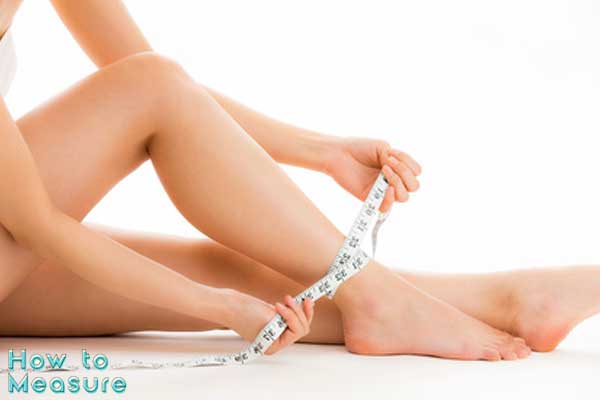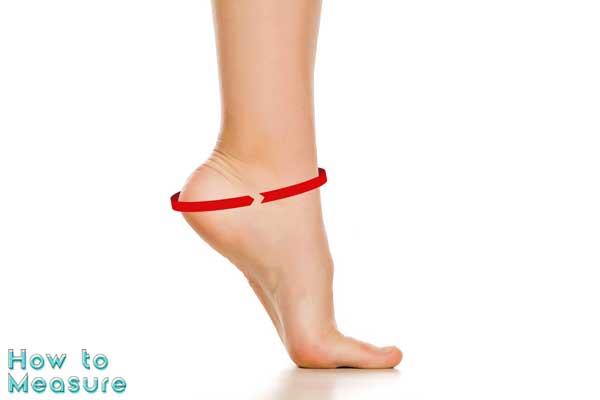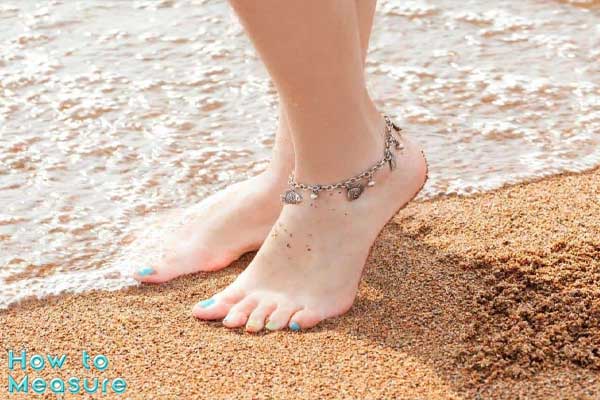Measuring ankle size accurately is crucial for various reasons, including selecting the right footwear, managing medical conditions, and tracking changes in ankle dimensions over time. Whether you’re an athlete, a healthcare professional, or someone seeking to ensure optimal ankle health, understanding how to measure ankle size correctly is essential. In this guide, we will explore different methods and provide step-by-step instructions to help you accurately measure your ankle size. By following these techniques, you can gather precise measurements that will assist you in making informed decisions regarding ankle-related concerns. Let’s dive into the details and discover how to measure your ankle size effectively.
How to measure ankle width for shoes?
To measure ankle width for shoes, you can follow these steps:
- Prepare the necessary tools: You will need a flexible measuring tape and a pen or pencil to mark the measurement.
- Sit down and position your foot: Sit comfortably with your foot relaxed and your leg at a 90-degree angle.
- Locate the ankle bone: Find the bony prominence inside your ankle, known as the medial malleolus. It’s the bony bump that can be felt on the inner side of the ankle.
- Measure the circumference: Take the flexible measuring tape and wrap it around the narrowest part of your ankle, just above the medial malleolus. Ensure the tape is snug but not too tight, allowing for a comfortable fit.
- Read the measurement: Look at the point where the end of the measuring tape meets the rest of the tape. Note the measurement in inches or centimeters.
- Repeat for accuracy: To ensure precision, it’s recommended to repeat the measurement one or two more times. Compare the results and take the average if there are any discrepancies.
- Record the measurement: Write down the ankle width measurement for future reference when selecting shoes. This measurement will help you find shoes that provide a comfortable fit around your ankles.
Remember, accurate ankle width measurements are important for finding support and comfortable shoes. Different shoe brands and styles may have varying ankle widths, so having this measurement will help you make informed decisions when choosing footwear.

How to measure ankle circumference accurately?
To measure ankle circumference accurately, follow these step-by-step instructions:
- Gather the necessary tools: You will need a flexible measuring tape and a mirror (optional but helpful).
- Prepare the ankle: Ensure your ankle is bare and free from any clothing or footwear that might interfere with the measurement.
- Find the bony protrusion: Locate the prominent bone inside your ankle, the medial malleolus. It is the bony bump that can be felt on the inner side of the ankle.
- Position the measuring tape: Wrap the flexible measuring tape around your ankle just above the medial malleolus. Ensure the tape is snug but not too tight, allowing for a comfortable fit.
- Maintain proper alignment: Ensure the measuring tape is parallel to the ground and perpendicular to your lower leg. This will help maintain accuracy in the measurement.
- Take the measurement: Read it on the tape at the point where it overlaps. Take note of the circumference in inches or centimeters.
- Repeat for consistency: To ensure accuracy, repeat the measurement one or two more times. Compare the results to ensure consistency, and take the average for any discrepancies.
- Optional: If you have difficulty measuring independently, use a mirror or ask someone for assistance to ensure a more precise measurement.
By following these steps, you can accurately measure the circumference of your ankle. Remember to record the measurement for future reference or when selecting footwear or managing any ankle-related concerns.
What is the correct way to measure ankle size?
To measure ankle size accurately, follow these steps:
- Gather the necessary tools: You will need a flexible measuring tape and a pen or pencil to mark the measurement.
- Prepare the ankle: Ensure your ankle is bare and free from any clothing or footwear that might interfere with the measurement.
- Find the bony protrusion: Locate the prominent bone inside your ankle, the medial malleolus. It is the bony bump that can be felt on the inner side of the ankle.
- Position the measuring tape: Wrap the flexible measuring tape around your ankle just above the medial malleolus. Ensure the tape is snug but not too tight, allowing for a comfortable fit.
- Maintain proper alignment: Ensure the measuring tape is parallel to the ground and perpendicular to your lower leg. This will help maintain accuracy in the measurement.
- Read the measurement: Look at the point where the end of the measuring tape meets the rest of the tape. Take note of the measurement in inches or centimeters.
- Optional: To ensure accuracy, repeat the measurement one or two more times. Compare the results to ensure consistency, and take the average for any discrepancies.
- Record the measurement: Write down the ankle size measurement for future reference, especially if you need it for footwear selection, medical purposes, or tracking changes over time.
By following these steps, you can measure your ankle size accurately. Remember that proper measurement is essential for choosing well-fitting shoes, managing medical conditions, and monitoring any changes in ankle dimensions.
What tools or instruments can be used to measure ankle size?
When it comes to measuring ankle size, you can use the following tools or instruments:
- Flexible Measuring Tape: A flexible measuring tape is a common and versatile tool for measuring ankle size. It allows for easy wrapping around the ankle and provides accurate circumference measurements.
- Seamstress Tape Measure: Similar to a flexible measuring tape, a seamstress tape measure can measure ankle size. It typically comes in a compact form and is easy to handle.
- Caliper: In some specialized cases, a caliper can measure ankle size. Calipers are more commonly used to obtain precise measurements in medical or research settings.
- Ankle Sizing Tool: Some shoe stores or brands may provide specific ankle sizing tools. These tools are designed to measure ankle dimensions accurately and aid in selecting the right shoe size.
- 3D Foot Scanners: Advanced footwear technologies may utilize 3D foot scanners to capture detailed measurements of the foot and ankle. These scanners create a digital model of the foot, including ankle size, to assist in finding the optimal shoe fit.
While a flexible measuring tape is typically sufficient for most individuals, other tools or instruments may be used depending on specific requirements or preferences. Choose the method that is most accessible and convenient for you when measuring ankle size.
Are there any specific techniques to measure ankle swelling or edema?
Yes, there are specific techniques to measure ankle swelling or edema. Here are a few methods commonly used by healthcare professionals:
- Perimeter Measurement: Using a flexible measuring tape, measure the circumference of the ankle at the narrowest point above the ankle bone (medial malleolus). Take note of the measurement in inches or centimeters. This method helps track changes in swelling over time.
- Pitting Edema Assessment: Press your thumb against the swollen area for a few seconds, then release. Observe if a visible indentation or “pit” remains. Grade the edema on a scale of 1 to 4, where 1 indicates mild pitting, and 4 indicates severe pitting.
- Volume Measurement: Specialized instruments like a perometer or water displacement method can be used to measure the volume of the swollen ankle. These devices provide more precise measurements but are typically used in clinical or research settings.
- Comparison to Contralateral Ankle: Compare the size and appearance of the swollen ankle to the unaffected or contralateral ankle. Note any noticeable differences in size, shape, or symmetry.
It’s important to consult a healthcare professional to assess and diagnose ankle swelling or edema accurately. They can guide the most appropriate technique to use and help determine the underlying cause of the swelling.

How can I measure ankle size for compression socks or braces?
To measure ankle size for compression socks or braces, follow these steps:
- Gather the necessary tools: You will need a flexible measuring tape and a pen or pencil to mark the measurement.
- Sit down and position your foot: Sit comfortably with your foot relaxed and your leg at a 90-degree angle.
- Locate the ankle bone: Find the bony prominence inside your ankle, known as the medial malleolus. It’s the bony bump that can be felt on the inner side of the ankle.
- Measure the circumference: Take the flexible measuring tape and wrap it around the narrowest part of your ankle, just above the medial malleolus. Ensure the tape is snug but not too tight, allowing for a comfortable fit.
- Read the measurement: Look at the point where the end of the measuring tape meets the rest of the tape. Note the measurement in inches or centimeters.
- Consider the sizing guidelines: Compression socks or braces typically come with sizing charts provided by the manufacturer. Refer to these charts and compare your ankle circumference measurement to find the appropriate size.
- Check for additional measurements: Depending on the product, additional measurements may be needed, such as calf circumference or length. Follow the manufacturer’s guidelines for these measurements if necessary.
- Consult a healthcare professional if needed: If you have specific medical conditions or concerns, it’s advisable to consult a healthcare professional or a specialist who can guide the appropriate size and type of compression socks or braces.
By following these steps and considering the sizing guidelines provided by the manufacturer, you can measure your ankle size accurately for compression socks or braces. Proper fitting is essential to ensure the effectiveness and comfort of these supportive garments.
Ankle Size Chart
| Ankle Size (Inches) | Ankle Size Category |
|---|---|
| Up to 8 | Small |
| 8 – 9 | Medium |
| 9 – 10 | Large |
| 10 and above | Extra Large |
Please remember that different manufacturers or brands may have their sizing guidelines. It’s always recommended to refer to the specific size charts the manufacturer provides when selecting footwear or other ankle-related products.
What are the standard units of measurement for ankle size?
The standard units of measurement for ankle size can vary depending on the region or country. The most commonly used units are inches (in) and centimeters (cm).
Ankle size is often measured in inches in the United States and some other countries. A flexible measuring tape is used to measure the circumference of the ankle, and the measurement is recorded in inches.
In many parts of the world, including Europe, ankle size is typically measured in centimeters. The measurement is obtained using a flexible measuring tape, and the circumference is recorded in centimeters.
It’s important to note that conversion between inches and centimeters is straightforward. One inch is approximately equal to 2.54 centimeters. So, if you have ankle measurements in one unit, you can easily convert them to the other using the appropriate conversion factor.
When measuring ankle size or referring to sizing charts for shoes, compression socks, or other ankle-related items, it’s essential to be aware of the unit of measurement used and ensure consistency throughout the process.
Are there any considerations for measuring ankle size in children?
Yes, there are a few considerations to keep in mind when measuring ankle size in children:
- Age and Development: Children’s ankles change as they grow and develop. Younger children may have softer and more elastic ankle tissues, affecting measurement accuracy. Take care to measure gently and avoid excessive pressure.
- Cooperation and Comfort: Children may feel uneasy or resistant when having their ankles measured. Ensure that the child is comfortable and willing to participate in the process. Offer reassurance and make it a positive experience to encourage cooperation.
- Flexible Measuring Tape: Use a flexible measuring tape appropriate for the child’s size. Consider using a measuring tape with child-friendly designs or colors to make it more engaging and less intimidating.
- Accompanying Adults: Younger children may require assistance from an adult to ensure the accuracy of the measurement. The adult can help position the measuring tape correctly and keep the child calm.
- Consider Shoe Size: When measuring ankle size for shoe fitting, consider the child’s current size and growth potential. Measuring both foot length and ankle circumference is advisable to ensure the best fit for growing feet.
- Take Multiple Measurements: To account for any variations or inconsistencies, measuring the child’s ankle size multiple times can be beneficial. This helps ensure accuracy and allows for averaging the measurements if needed.
Remember that measuring ankle size in children should be done with care and sensitivity. If you have concerns or are uncertain, consult a pediatrician, orthopedic specialist, or a professional experienced in measuring children’s ankles for further guidance.
Can I measure ankle size at home?
Yes, you can measure ankle size at home. Measuring your ankle size using a flexible measuring tape and following the correct techniques described earlier. It is a relatively simple process that you can perform on your own or with the assistance of someone else if needed.
You can obtain an accurate ankle size measurement at home by following the steps outlined, such as locating the ankle bone, positioning the measuring tape correctly, and taking the circumference measurement.
Measuring your ankle size at home can be helpful for various reasons, such as selecting appropriate footwear, monitoring changes in ankle dimensions, or managing certain medical conditions. However, if you have specific concerns or require precise measurements for medical purposes, it’s always advisable to consult a healthcare professional who can provide guidance and ensure accuracy.
Why is it important to measure ankle size correctly?
Measuring ankle size correctly is important for several reasons:
- Proper Footwear Selection: Accurate ankle size measurements help select footwear that fits well and provides optimal comfort. Ill-fitting shoes can lead to discomfort, blisters, or foot conditions like bunions or corns. By measuring ankle size correctly, you can ensure the right fit, which promotes foot health and prevents potential foot problems.
- Medical Considerations: Ankle size measurements are crucial in managing certain medical conditions. For example, individuals with lymphedema, edema, or circulatory issues may require compression socks or braces. Properly measuring ankle size ensures the appropriate size and compression level for effective treatment.
- Tracking Changes and Progress: Measuring ankle size over time allows you to track changes and monitor progress. This is particularly important when ankle swelling, edema, or other conditions fluctuate. Accurate measurements provide valuable data for healthcare professionals, aiding in assessing treatment effectiveness and overall ankle health.
- Rehabilitation and Injury Management: In cases of ankle injuries or rehabilitation, knowing the accurate ankle size can guide the selection of braces, supports, or splints to provide the necessary stability and support. Properly fitting devices aid in the healing process and help prevent further damage or re-injury.
- Research and Data Analysis: Accurate ankle size measurements contribute to research studies and data analysis related to foot and ankle health. Standardized measurements enable researchers to compare findings across different populations and assess trends or patterns in ankle dimensions.
In summary, measuring ankle size correctly is vital for selecting appropriate footwear, managing medical conditions, tracking changes, aiding rehabilitation, and contributing to research. It promotes foot health, comfort, and overall well-being.
Conclusion
In conclusion, measuring ankle size accurately is essential for various reasons, including selecting well-fitting shoes, managing medical conditions, tracking changes over time, and ensuring optimal comfort and support. You can obtain reliable measurements by following the proper techniques, such as locating the ankle bone, using a flexible measuring tape, and maintaining correct alignment. It is important to record the measurements in either inches or centimeters and refer to appropriate sizing charts provided by manufacturers when selecting footwear or other ankle-related products. Remember that it is always advisable to consult a healthcare professional for specific medical concerns or precise measurements. By measuring ankle size correctly, you can make informed decisions about your footwear, promote foot health, and enhance your overall well-being.











